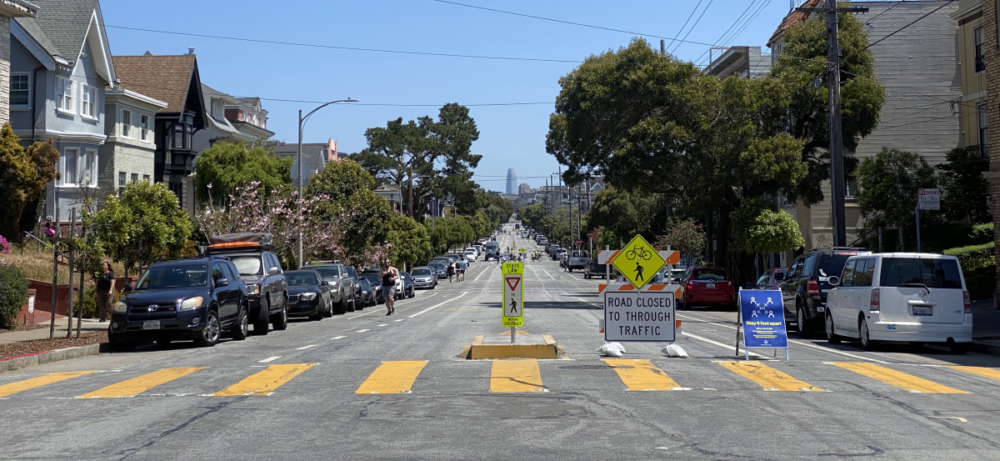By unanimous vote Tuesday and with overwhelming public support, the first batch of San Francisco Slow Streets have been approved to outlast the Covid-19 pandemic.
Transit officials quickly rolled out the Slow Streets program in April of last year as a way to provide more outdoor distancing space for residents to walk and bike during the local emergency order. The program aims to discourage through traffic on designated Slow Streets, but allows residents who drive to gain access to their street. The temporary program will expire 120 days after city officials lift the local emergency order. There are a total of 31 Slow Streets citywide.
The San Francisco Municipal Transportation Agency Board of Directors approved four corridors for permanent Slow Streets status:
- Golden Gate Avenue from Masonic Avenue to Broderick Street
- Lake Street from 28th to 2nd avenues
- Sanchez Street from 23rd to 30th streets
- Shotwell Street from Cesar Chavez to 14th streets
Shannon Hake, the agency’s Slow Streets program manager, said staff chose the first four corridors for consideration because they meet specific criteria. Ideal streets are residential with low traffic volume and have strong neighborhood support. Additionally, staff must assess how a permanent Slow Streets conversion will impact other street planning and the transportation network.
Three to four months of community outreach will be conducted following board approval of a corridor extension, which is already in process for Sanchez and Shotwell streets, Hake said. She anticipates public hearing on the designs will take place late this month.

Outreach for the Lake Street and Golden Gate Avenue corridors will begin in September, Hake said.
Staff will evaluate each corridor after 18 months and present the board with findings.
Hake said permanent Slow Street designs will be customized to meet the needs of each unique roadway. For example, wayfinding signs and crosswalks are proposed for Sanchez Street as a way to address quality of life impacts and increase usage of the street.
Turn restrictions will be included in the design for the narrow Shotwell Street corridor.
The SFMTA is still determining how to best construct barriers and signage. Hake said materials used so far have been less than perfect and the agency is looking into ways to “harden” materials, citing an issue that emerged over the weekend someone used a “power saw” to cut some of the posts.
During the meeting, most callers voiced support for making all four of the Slow Streets corridors permanent, many saying the temporary traffic reductions have allowed them to walk and bike safely.
Robin Cutner, representing the North of Panhandle Neighborhood Association, said the Golden Gate Avenue Slow Street has been a valuable space for the community, adding:
“It is a safer route for bicycling and walking. It’s where local families began a tradition to meet on the street for Friday night happy hours. It’s where neighbors cultivate planters and bring greenery to the public realm. It’s become a place for kids to safely stretch out and play and it’s become a safer route to many neighborhood schools.”
Still, some callers criticized the move to keep the Slow Streets status on their blocks. Some residents complained that the corridors have attracted amplified sound from bands playing on the street and confrontations as people try to access their garages. Another concern was the impact nearby streets once pre-pandemic traffic levels return.
One caller who did provide a name, said that Sanchez Street under the temporary program has already diminished the area’s quality of life.
They said:
“The current program is for residents of Sanchez Street. We have endured over a year of excessive noise, trash, crime, and community conflict created by this program.”
Stressing that Slow Streets are meant to provide space for all modes of transportation, SFMTA Director of Transportation Jeffrey Tumlin said:
“We merely ask that everyone respect the right for everyone else to share that space.”
Jerold serves as a reporter and San Francisco Bureau Chief for SFBay covering transportation and occasionally City Hall and the Mayor's Office in San Francisco. His work on transportation has been recognized by the San Francisco Press Club. Born and raised in San Francisco, he graduated from San Francisco State University with a degree in journalism. Jerold previously wrote for the San Francisco Public Press, a nonprofit, noncommercial news organization. When not reporting, you can find Jerold taking Muni to check out new places to eat in the city.
